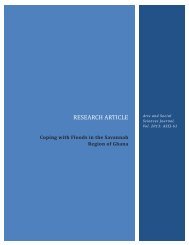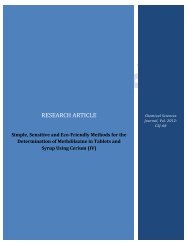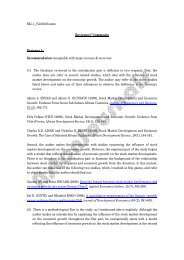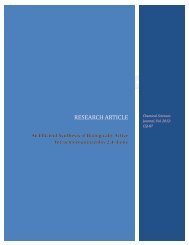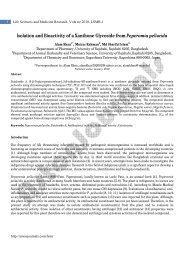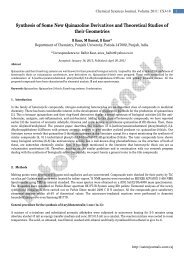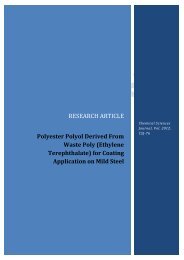Rapid and Sensitive Spectrophotometric ... - AstonJournals
Rapid and Sensitive Spectrophotometric ... - AstonJournals
Rapid and Sensitive Spectrophotometric ... - AstonJournals
You also want an ePaper? Increase the reach of your titles
YUMPU automatically turns print PDFs into web optimized ePapers that Google loves.
RESEARCH ARTICLE<br />
<strong>Rapid</strong> <strong>and</strong> <strong>Sensitive</strong><br />
<strong>Spectrophotometric</strong> Measurement<br />
of Non-Specific Beta Blocker<br />
Propranolol Hydrochloride Using<br />
Three Sulphonphthalein Dyes In<br />
Pure Form, Pharmaceuticals <strong>and</strong><br />
Human Urine<br />
Chemical Sciences<br />
Journal, Vol. 2012:<br />
CSJ-80
Chemical Sciences Journal, Vol. 2012: CSJ-80<br />
1<br />
<strong>Rapid</strong> <strong>and</strong> <strong>Sensitive</strong> <strong>Spectrophotometric</strong> Measurement of Non-<br />
Specific Beta Blocker Propranolol Hydrochloride Using Three<br />
Sulphonphthalein Dyes In Pure Form, Pharmaceuticals<br />
<strong>and</strong> Human Urine<br />
KN Prashanth, K Basavaiah*, MS Raghu<br />
Department of Chemistry, University of Mysore, Mysore, Karnataka, India.<br />
*Correspondence to: Kanakapura Basavaiah, basavaiahk@yahoo.co.in<br />
Accepted: Nov 13, 2012; Published: Nov 24, 2012<br />
Abstract<br />
Three sensitive, selective, rapid <strong>and</strong> easily reproducible spectrophotometric methods (A-C) have been developed for the<br />
determination of propranolol hydrochloride (PPH) as a hydrochloride free base propranolol (PPL) in bulk sample <strong>and</strong> in its<br />
dosage forms. These methods are based on ion-pair formation between propranolol as a hydrochloride <strong>and</strong> free base <strong>and</strong> three<br />
acidic (sulphonphthalein) dyes; namely bromothymol blue (BTB), bromocresol green (BCG) <strong>and</strong> bromocresol purple (BCP) which<br />
induces an instantaneous bathochromic shift of the maximum in the drug spectrum. The colored products are measured at 420<br />
nm (PPL-BTB complex <strong>and</strong> PPL-BCP complex) <strong>and</strong> 425 nm (PPL-BCG complex). The reactions were extremely rapid at room<br />
temperature <strong>and</strong> the absorbance values remained constant for 90 min (method B), <strong>and</strong> over 24 hrs (method A <strong>and</strong> C).<br />
Conformity to Beer’s law in the range 0.4-7.0 µg ml -1 for methods A <strong>and</strong> B <strong>and</strong> 0.5-8.4 µg ml -1 for method C enabled the assay of<br />
dosage forms of the drug. The proposed methods were compared with a reference method; the results obtained were of equal<br />
accuracy <strong>and</strong> precision. In addition, these methods were also found to be specific for the analysis of PPH in the presence of<br />
excipients, which are co-formulated in the drug. Satisfactory results were obtained when applied to spiked human urine. A<br />
more detailed investigation of the propanolol hydrochloride ion pair complexes were made with respect to its composition<br />
indicated by stability constant values.<br />
Keywords: Propranolol hydrochloride; spectrophotometric assay; ion-pair complexes; pharmaceuticals; human urine.<br />
1. Introduction<br />
Propranolol hydrochloride (PPH), (2RS)-1-[(1-Methylethyl)amino]-3-(naphthalen-1-yloxy)propan-2-ol hydrochloride<br />
(Figure 1), is a highly effective antihypertensive <strong>and</strong> antianginal drug. Being a nonselective prototype betaadrenergic<br />
receptor-blocking agent, it possesses no other autonomic nervous system activity <strong>and</strong> specifically<br />
competes with beta-adrenergic receptor-stimulating agents for available receptor sites. The drug is widely used in<br />
clinical practice for the treatment of cardiac arrhythmia, hypertension <strong>and</strong> angina pectoris [1], dysfunctional<br />
labour, anxiety <strong>and</strong> migraine [2, 3]. It is also abused in sports involving little physical activity to reduce cardiac,<br />
contraction, heart rate <strong>and</strong> coronary blood flow [4]. Therefore, it has been included in the list of forbidden<br />
substances by the International Olympic Committee [5]. Monitoring of propranolol in biological fluids is important<br />
not only in clinical practice but also in the field of doping control. The drug is official in BP [6] <strong>and</strong> USP [8], which<br />
describe UV-spectrophotometric methods for the assay of PPH after extraction into methanol, <strong>and</strong> also in IP [7]<br />
which describes a potentiometric titration of drug in ethanol with 0.1 M NaOH.<br />
O<br />
OH<br />
N<br />
H2<br />
.Cl<br />
Figure 1: Structure of propranolol hydrochloride.<br />
http://astonjournals.com/csj
2 Research Article<br />
Due to its therapeutical <strong>and</strong> pharmacological relevance, several methods have been reported for PPH <strong>and</strong><br />
include thin layer chromatography [9], UV-spectrophotometry [10-13], fluorimetry [14], voltammetry [15] <strong>and</strong><br />
chemiluminometry [16,17]. These techniques involve an expensive experimental set up <strong>and</strong> are not always easily<br />
accessible. One titrimetric [18] <strong>and</strong> a few visible spectrophotometric [19-34] methods have also been reported.<br />
Visible spectrophotometry, because of its simplicity <strong>and</strong> cost-effectiveness, sensitivity <strong>and</strong> selectivity <strong>and</strong><br />
fair accuracy <strong>and</strong> precision is routinely used in many industrial quality control laboratories. Several visible<br />
spectrophotometric methods based on different reaction schemes are found in the literature for PPH.<br />
A method for the assay of PPH using diazotized 4-amino-3,5-dinitrobenzoic acid (ADBA) as the<br />
chromogenic derivatizing reagent reported by Idowu et al. [19]. Bh<strong>and</strong>ari et al. [20] reported a method based on<br />
the reaction of PPH with 1-chloro-2,4-dinitrobenzene, forming a complex, which absorb maximally at 314.6 nm. In<br />
a method reported by Golcu et al. [21], PPH was reacted with copper (II) or cobalt (II) <strong>and</strong> the coloured complexes<br />
were measured at 548 or 614 nm. El-Ries et al. [22] proposed two spectrophotometric methods based on the<br />
charge-transfer complex reaction of PPH with π-acceptors, tetracyanoethylene (TCNE), or chloranilic acid (CLA) to<br />
give highly coloured complex species which are quantitated spectrophotometrically, absorbing maximally at 415 or<br />
510 nm. Salem [23] used similar reactions for the spectrophotometric determination of PPH which are based on<br />
the reaction of PPH as n-electron donor with the sigma-acceptor iodine <strong>and</strong> π-acceptors such as 7,7,8,8-<br />
tetracyaniquinodimethane, 2,3-dichloro-5,6-dicyano-1,4-benzoquinone, tetracyanoethylene, bromanil <strong>and</strong><br />
chloranil. The resulting CT complexes were measured at 365, 840, 420, 470, 450 <strong>and</strong> 440 nm, respectively. Hussain<br />
et al. [24] reported a method based on the redox reaction of PPH with cerium (IV) in H 2 SO 4 medium on heating <strong>and</strong><br />
the developed color was measured at 478 nm. El-Emam et al. [25] reported a method based on oxidative-coupling<br />
reaction in which a mixture of an acidic solution of MBTH <strong>and</strong> PPH was treated with cerium (IV) <strong>and</strong> the resulting<br />
orange colour peaking at 496 nm was measured.<br />
In addition to direct methods described above, several indirect methods based on a variety of reaction<br />
chemistries are also found in the literature. A spectrophotometric method proposed by Basavaiah et al. [26] makes<br />
use of the reaction between chloride of PPH <strong>and</strong> mercury(II) thiocyanate in which thiocyanate ions displaced<br />
complexed with iron(III) for subsequent measurement at 460 nm. In a spectrophotometric method reported by<br />
Basavaiah et al. [27], the unreacted cerium(IV) sulphate was treated with iron(II) <strong>and</strong> the iron(III) was complexed<br />
with thiocyanate <strong>and</strong> measured at 480 nm. Similar method reported by Basavaiah et al. [28] is based on the<br />
oxidation of PPH by a known excess of CAT in acid medium followed by determination of the unreacted oxidant by<br />
reacting with metal <strong>and</strong> sulphanilic acid. The same authors reported another spectrophotometric method in which<br />
the unreacted oxidant metavanadate was determined by reacting with diphenylamine, <strong>and</strong> the absorbance<br />
measured at 560 nm [29]. A method reported by Basavaiah et al. [30] involves the addition of a known excess of<br />
bromate-bromide mixture to an acidified solution of the drug <strong>and</strong> determination of the unreacted bromine by its<br />
bleaching action on methyl orange acid color <strong>and</strong> the absorbance measured at 510 nm. El-Didamony [31] reported<br />
three methods based on oxidation-bromination reaction of PPH by bromine, generated in situ by the action of acid<br />
on a bromate-bromide mixture, followed by determination of unreacted bromine by three different reaction<br />
schemes. In one method the residual bromine was determined by indigo carmine dye. In the other two methods,<br />
the residual bromine was determined by treating with a known excess of iron(II) <strong>and</strong> the resulting iron(III) was<br />
complexed with thiocyanate or the residual iron(II) with 1,10-phenanthroline. Gowda et al. [32] reported two<br />
procedures, similar to the above, in which PPH was oxidized by a known excess of NBS in H 2 SO 4 medium followed<br />
by the reaction of unreacted oxidant with promethazine hydrochloride (PH) or methdilazine hydrochloride (MDH)<br />
to yield red coloured products with absorption maximum at 515 or 513 nm. Two methods described by Al-Attas et<br />
al. [33] based on the oxidation of PPH by a known excess of N-bromosuccinimide (NBS), in an acidic medium<br />
followed by the reaction of excess oxidant with amaranth dye. Sastry et al. [34] devised one more method by<br />
treating PPH with a known excess of NBS in HCl medium, <strong>and</strong> after 10 min, the unreacted oxidant was determined<br />
by reacting with celestine blue <strong>and</strong> measuring the absorbance at 540 nm.<br />
The above reported methods suffer from disadvantages like heating step, slow reaction, extraction step,<br />
multi step reactions, tedious control of experimental variables <strong>and</strong> less sensitivity. The present investigation<br />
involves the development of accurate, reproducible, <strong>and</strong> adequately sensitive three spectrophotometric methods<br />
based on the formation of ion- pair complexes between hydrochloride free propranolol (PPL) with<br />
sulphonphthalein dyes namely bromothymol blue (BTB), bromocresol green (BCG) <strong>and</strong> bromocresol purple (BCP).<br />
The proposed methods were applied to the determination of PPH in pharmaceutical formulation <strong>and</strong> in human<br />
urine. No interference was observed in the assay of PPH from common excipients found in pharmaceutical<br />
http://astonjournals.com/csj
Chemical Sciences Journal, Vol. 2012: CSJ-80<br />
3<br />
formulation <strong>and</strong> other biological materials present in urine. These methods are validated by the statistical data.<br />
These methods provide economic procedures, less time consuming, <strong>and</strong> more sensitive compared with other<br />
reported spectrophotometric methods (Table 1). The proposed methods are simple <strong>and</strong> suitable for routine<br />
determination of PPH in quality control laboratories.<br />
Table 1: Comparison of the proposed <strong>and</strong> the existing visible spectrophotometric methods.<br />
Reagent/s λ max ,<br />
nm<br />
Beer’s law<br />
range, µg ml -1<br />
(ε in l mol -1 cm -1 )<br />
Remarks<br />
4-amino-3,5-dinitrobenzoic 470 1.0-8.0 Heating required 19<br />
acid<br />
1-chloro-2,4-dinitrobenzene 314.6 - - 20<br />
Copper(II) or Cobalt(II) 548/614 2x10 -5 -1×10 -2 M - 21<br />
Tetracyanoethylene, 415<br />
- Use of large quantity of organic solvents 22<br />
chloranilic acid<br />
510<br />
σ <strong>and</strong> π-acceptors - 4-120 Use large quantity of organic solvents; less<br />
23<br />
sensitive<br />
Cerium(IV) 478 15-350 Involves boiling for 25 min; less sensitive 24<br />
Cerium(IV)-MBTH 496 1-10 Uses an expensive chemical 25<br />
Mercury(II) thiocyanateiron(III)<br />
460 10-50<br />
- 26<br />
(2.63×10 3 )<br />
Cerium (IV)-iron (II) 480 0.0-5.0<br />
Multi-step reaction 27<br />
sulphate-thiacyanate<br />
(3.6×10 4 )<br />
Chloramine-T-metol <strong>and</strong> 520 0.0-3.0 Less sensitive, multi step reaction, critical pH. 28<br />
sulphanilic acid<br />
(7.1×10 3 )<br />
Sodium metavanadatediphenylamine<br />
560 0.0-4.0<br />
Multi-step reaction 29<br />
(5.33×10 4 )<br />
Bromate-bromide-methyl 510 0.5-3.5<br />
Multi-step reaction 30<br />
orange<br />
(6.66×10 4 )<br />
Bromate-bromide<br />
a)Indigo carmine<br />
610 1.0-13.0<br />
Multi-step reaction 31<br />
Ref.<br />
b)Fe(III)+thiocyanate<br />
480<br />
4.0-12.0<br />
c)Fe(III)+1,10-phenanthroline 510 2.0-9.0<br />
a)NBS-PH<br />
515 0.5-12.5<br />
Multi-step reaction 32<br />
(1.36x10 4 )<br />
b)NBS-MDH<br />
513 0.3-16.0<br />
(2.55x10 4 )<br />
a)N-bromosuccinimide-<br />
0.2-6.4 Multi-step reaction 33<br />
amaranth<br />
NBS-Celestine blue 540 0.4-3.0 Multi-step reaction 34<br />
a) Bromo thymol 420 0.4-7.0<br />
Simple, rapid, sensitive, selective <strong>and</strong> no Proposed<br />
blue (BTB)<br />
(ε =3.55×10 4 ) heating step. Use of single reagent <strong>and</strong> no methods<br />
b) Bromo cresol<br />
425 0.4-7.0<br />
extraction step involved.<br />
green (BCG)<br />
(ε =3.12×10 4 )<br />
c) Bromo cresol<br />
420 0.48-8.4<br />
purple (BCP)<br />
(ε =2.94×10 4 )<br />
2. Methods<br />
2.1 Instrument<br />
All the absorbance measurements were made using a Systronics model 106 digital spectrophotometer provided<br />
with 1cm matched quartz cells.<br />
http://astonjournals.com/csj
4 Research Article<br />
2.2 Materials<br />
Pharmaceutical grade propranolol hydrochloride (PPH) was received from Cipla India Ltd., Mumbai, India, as a gift<br />
<strong>and</strong> used as received. The following formulations were obtained from commercial sources <strong>and</strong> subjected to<br />
analysis: Monoprolol-20 (Cosmo Life Sciences Ltd., India), Ciplar – 40 (Cipla Ltd., India) <strong>and</strong> Betacap-40 from (Sun<br />
Pharma Ltd., India).<br />
2.3 Reagents <strong>and</strong> chemicals<br />
All the reagents <strong>and</strong> solvents used were of analytical-reagent grade. Bromothymol blue (BTB), bromocresol green<br />
(BCG) <strong>and</strong> bromocresol purple (BCP) (all from Loba Chemie Ltd., Mumbai, India) solutions were prepared daily as<br />
0.1% BTB <strong>and</strong> BCP <strong>and</strong> 0.05% BCG in dichloromethane.<br />
2.4 St<strong>and</strong>ard stock solution of PPL<br />
Pure propranolol hydrochloride (11.4 mg) was dissolved in 20 ml water in a 125 ml separating funnel, 5 ml of liquid<br />
ammonia was added followed by 20 ml of dichloromethane. The content was shaken for 15 minutes. The lower<br />
organic layer was collected in a beaker containing anhydrous sodium sulphate. The water-free organic layer was<br />
transferred into a 100 ml calibrated flask <strong>and</strong> diluted to the volume with the same solvent to get 100 µg ml -1 with<br />
respect to PPL (hydrochloride free propranolol). This solution was diluted appropriately with dichloromethane to<br />
get working concentrations of 10 µg ml -1 in both the methods A <strong>and</strong> B, <strong>and</strong> 12 µg ml -1 for use in method C,<br />
respectively.<br />
2.5 Recommended Procedures<br />
2.5.1 BTP method (method A)<br />
Different aliquots (0.2, 0.5, 1.0, 2.0, 3.0 <strong>and</strong> 3.5 ml) of a st<strong>and</strong>ard PPL (10 µg ml -1 ) solution were transferred into a<br />
series of 5 ml calibrated flasks using a micro burette <strong>and</strong> to each flask was added 1 ml of 0.1% BTB solution. The<br />
mixture was diluted to the volume with dichloromethane <strong>and</strong> mixed well. The absorbance of resulting yellow<br />
colored solution was measured at 420 nm against a reagent blank.<br />
2.5.2 BCG method (method B)<br />
Varying aliquots (0.2, 0.5, 1.0, 2.0, 3.0 <strong>and</strong> 3.5 ml) of a st<strong>and</strong>ard PPL (10 µg ml -1 ) solution were transferred into a<br />
series of 5 ml calibrated flasks using a micro burette <strong>and</strong> to each flask was added 1 ml of 0.05% BCG solution. The<br />
mixture was diluted to the volume with dichloromethane <strong>and</strong> mixed well. The absorbance of resulting yellow<br />
colored solution was measured at 425 nm against a reagent blank.<br />
2.5.3 BCP method (method C)<br />
Into a series of 5 ml calibration flasks, aliquots (0.25, 0.5, 1.0, 2.0, 3.0 <strong>and</strong> 3.5 ml) of st<strong>and</strong>ard PPL solution (12 µg<br />
ml -1 ) equivalent to 0.6 – 8.4 µg ml -1 PPL were accurately transferred <strong>and</strong> the total volume in each flask was brought<br />
to 3.5 ml by adding dichloromethane. To each flask 1 ml of 0.1 % BCP solution in dichloromethane was added <strong>and</strong><br />
mixed well. The absorbance of the yellow colored ion-pair complex was measured at 420 nm against the reagent<br />
blank.<br />
2.5.4 Procedure for dosage forms<br />
Ten tablets or content of ten capsules were weighed accurately <strong>and</strong> ground into fine powder. An amount of the<br />
powder equivalent to 11.4 mg of PPH was weighed into a 125 ml separating funnel. The extraction procedure used<br />
for pure drug was followed for tablet/capsule powder. The resulting solution was diluted to get working<br />
concentration (10 <strong>and</strong> 12 µg ml -1 PPL) <strong>and</strong> suitable aliquots were analyzed following the procedures described<br />
above.<br />
2.5.5 Procedures for selectivity study<br />
A placebo blank of the composition: talc (100 mg), starch (50 mg), acacia (50 mg), methyl cellulose (100 mg),<br />
sodium citrate (50 mg), magnesium stearate (100 mg), <strong>and</strong> sodium alginate (50 mg) was prepared <strong>and</strong> 20 mg was<br />
extracted with dichloromethane <strong>and</strong> solutions were made as described under preparation of dosage forms. A<br />
convenient aliquot of solution was subjected to analysis following the recommended procedures.<br />
http://astonjournals.com/csj
Chemical Sciences Journal, Vol. 2012: CSJ-80<br />
5<br />
To the 20 mg of the placebo blank, 11.4 mg of PPH was added <strong>and</strong> homogenized. The solution of the<br />
synthetic mixture equivalent to 100 μg ml - 1 of PPL was prepared as described earlier. The resulting solution was<br />
assayed (n = 5) by all the three methods after appropriate dilution.<br />
2.5.6 Procedure for spiked human urine<br />
Five ml of PPH free urine taken in a 125 ml separating funnel was spiked with 20 ml of aqueous solution containing<br />
11.4 mg of pure PPH <strong>and</strong> to the same solution, 5ml of liquid ammonia was added followed by 20 ml of ethyl<br />
acetate. The content was shaken for 15 min. The lower aqueous layer was discarded <strong>and</strong> the upper organic layer<br />
was collected in a beaker containing anhydrous sodium sulphate. The water-free organic layer was transferred into<br />
a dried beaker <strong>and</strong> evaporated on a hot water bath. The dry residue was dissolved in dichloromethane in a 100 ml<br />
calibrated flask, <strong>and</strong> diluted to the mark with solvent. This solution was diluted appropriately with<br />
dichloromethane to get working concentrations. An aliquot of resulting solution was analyzed following the<br />
procedures described above.<br />
2.5.7 Procedure for stoichiometric relationship<br />
Job’s method of continuous variations of equimolar solutions was employed: 5.78 × 10 -5 M each of PPL <strong>and</strong> BTB in<br />
dichloromethane (Method A) solutions, 5.78 × 10 -5 M each of PPL <strong>and</strong> BCG in dichloromethane (Method B)<br />
solutions <strong>and</strong> 1.93 × 10 -4 M each of PPL <strong>and</strong> BCP in dichloromethane (Method C) solutions were prepared<br />
separately. A series of solutions was prepared in which the total volume of PPL <strong>and</strong> dye was kept at 5 ml. The drug<br />
<strong>and</strong> reagent were mixed in various complementary proportions (0:5, 1:4, 2:3, …..5:0, inclusive) <strong>and</strong> completed as<br />
directed under the recommended procedures. The absorbance of the resultant ion-pair complex was measured at<br />
420 nm in method A <strong>and</strong> C, <strong>and</strong> 425 nm in method B.<br />
3. Results <strong>and</strong> Discussion<br />
The mechanism for the extraction-free ion pair complex formation between nitrogenous compound <strong>and</strong><br />
sulphonphthalein acid dyes were recently reported [35-37]. Similar reaction mechanism (Scheme 1) for ion pair<br />
complex formation between PPL <strong>and</strong> BTB, BCG or BCP is proposed. The PPH contains a secondary aliphatic amino<br />
group which forms ion-pair complex with sulphonphthalein acid dyes, BTB, BCG <strong>and</strong> BCP. Since ion-pair complex<br />
forms in non-polar solvents, the insolubility of PPH in any of the non-polar solvents was overcome by using PPH in<br />
its base form, PPL.<br />
The dyes employed have insignificant absorbance (Figure 2). The formation of intense yellow colored<br />
product with an absorption maximum at 425 or 420 nm is due to an opening of lactoid ring <strong>and</strong> subsequent<br />
formation of quinoid group [38]. It is supposed that the two tautomers are present in equilibrium but due to strong<br />
acidic nature of the sulphonic acid group, the quinoid moiety must predominate.<br />
3.1 Optimization of experimental variables<br />
3.1.1 Absorption spectra<br />
The absorption spectra of the ion-pair complexes, formed between PPL <strong>and</strong> each of BTB BCG <strong>and</strong> BCP, were<br />
recorded at 370-540 nm against respective reagent blank <strong>and</strong> the same are shown in Figure 2. The yellow ion-pair<br />
complexes showed maximum absorbance at 420 nm for PPL-BTB <strong>and</strong> PPL-BCG, <strong>and</strong> 425 nm for PPL-BCP (Figure 2).<br />
The measurements were thus made at these wavelengths.<br />
3.1.2 Effect of solvents<br />
The organic solvent exhibiting minimum blank absorbance in the presence of sulphonphthalein dyes alone is the<br />
ideal solvent for extraction-free ion pair technique. In order to select a suitable solvent for preparation of the<br />
reagent solutions used in the study, the reagents were prepared separately in different solvents such as 1,4-<br />
dioxane, chloroform, acetonitrile, acetone <strong>and</strong> dichloromethane, <strong>and</strong> the reaction of PPL with BTB, BCG or BCP was<br />
followed. Among the organic solvents studied (Figure 3), the order of blank absorbance for all the dyes was:<br />
dichloromethane
6 Research Article<br />
Br<br />
OH<br />
Br<br />
O<br />
Br<br />
O<br />
H 3C<br />
H 3C<br />
H 3C<br />
HO<br />
O<br />
HO<br />
HO<br />
H<br />
Br<br />
CH 3<br />
SO 2<br />
Br<br />
CH 3 SO 3H<br />
CH<br />
Br<br />
3<br />
SO 3<br />
BTB<br />
(lactoid ring)<br />
(quinoid ring)<br />
deprotonated dye<br />
Br<br />
O<br />
+<br />
H 3C<br />
Br<br />
O<br />
O<br />
N<br />
H<br />
O<br />
N<br />
H2<br />
H 3C<br />
OH<br />
HO<br />
H<br />
OH<br />
HO<br />
Br<br />
CH 3<br />
SO 3<br />
Br<br />
CH 3<br />
SO 3<br />
Propranolol base<br />
(PPL)<br />
1:1 ion-pair complexes of<br />
PPL-BTB (measured at 420 nm)<br />
(a)<br />
HO<br />
Br<br />
Br<br />
OH<br />
HO<br />
Br<br />
Br<br />
O<br />
HO<br />
Br<br />
Br<br />
O<br />
Br<br />
CH 3 O<br />
CH 3<br />
SO 2<br />
Br<br />
Br<br />
CH 3<br />
Br<br />
CH 3<br />
SO 3 H<br />
Br<br />
CH 3 CH 3<br />
SO 3<br />
Br<br />
+ H +<br />
BCG<br />
(lactoid ring)<br />
(quinoid ring)<br />
deprotonated dye<br />
O<br />
Propranolol base<br />
(PPL)<br />
Br<br />
Br<br />
N HO<br />
O<br />
H<br />
OH O N<br />
H2<br />
+<br />
Br<br />
Br H +<br />
OH<br />
+<br />
HO<br />
CH 3 CH 3<br />
Br<br />
SO 3<br />
+<br />
Br<br />
Br<br />
CH 3<br />
CH 3<br />
SO 3<br />
O<br />
Br<br />
(b)<br />
1:1 ion-pair complexes of<br />
PPL-BCG (measured at 425 nm)<br />
http://astonjournals.com/csj
Absorbance<br />
Chemical Sciences Journal, Vol. 2012: CSJ-80<br />
7<br />
O<br />
Br<br />
CH 3<br />
OH<br />
O<br />
Br<br />
CH 3<br />
O<br />
O<br />
Br<br />
CH 3<br />
O<br />
H 3 C<br />
O<br />
Br<br />
H 3 C<br />
Br<br />
H 3 C<br />
Br<br />
+ H +<br />
SO 2<br />
SO 3 H<br />
SO 3<br />
BCP<br />
(lactoid ring)<br />
(quinoid ring)<br />
deprotonated dye<br />
O<br />
Propranolol base<br />
(PPL)<br />
Br<br />
CH 3<br />
N O<br />
O<br />
H<br />
OH O N<br />
H2<br />
+<br />
H H +<br />
3 C<br />
Br<br />
OH<br />
SO 3<br />
+<br />
+<br />
O<br />
H 3 C<br />
Br<br />
CH 3<br />
SO 3<br />
O<br />
Br<br />
(c)<br />
1:1 ion-pair complexes of<br />
PPL-BCP (measured at 420 nm)<br />
Scheme 1: (a) Tentative reaction mechanism for PPL-BTB ion-pair complex formation,<br />
(b) Tentative reaction mechanism for PPL-BCG ion-pair complex formation,<br />
(c) Tentative reaction mechanism for PPL-BCP ion-pair complex formation.<br />
0.6<br />
0.5<br />
0.4<br />
Sample BTB<br />
Blank BTB<br />
Sample BCG<br />
Blank BCG<br />
Sample BCP<br />
Blank BCP<br />
0.3<br />
0.2<br />
0.1<br />
0.0<br />
360 380 400 420 440 460 480 500 520 540 560<br />
Wavelength, nm<br />
Figure 2: Absorption spectra (4 µg ml -1 of PPL in both methods A <strong>and</strong> B, <strong>and</strong> 4.8 µg ml -1 of PPL in method C)<br />
http://astonjournals.com/csj
Absorbance<br />
Absorbance<br />
8 Research Article<br />
0.6<br />
0.5<br />
PPL-BTB ion pair complex<br />
PPL-BTB blank<br />
PPL-BCG ion pair complex<br />
PPL-BCG blank<br />
PPL-BCP ion pair complex<br />
PPL-BCP blank<br />
0.4<br />
0.3<br />
0.2<br />
0.1<br />
0.0<br />
1,4-Dioxan Chloroform Acetonitrile Acetone Dichloromethane<br />
Solvents<br />
Figure 3: Effect of solvents on the formation of PPL-BTB complex (3.2 µg ml -1 PPL), PPL- BCG complex (4.0 µg ml -1<br />
PPL) <strong>and</strong> PPL-BCP complex (4.8 µg ml -1 PPL).<br />
3.1.3 Effect of dye concentration <strong>and</strong> reaction time<br />
The effect of the dye-concentration on the intensity of the color developed at selected wavelengths was studied by<br />
measuring the absorbance of solutions containing a fixed concentration of PPL (2.4, 3.5 <strong>and</strong> 5.0 μg ml -1 in methods<br />
A, B <strong>and</strong> C, respectively) <strong>and</strong> different amounts (0.5 - 3.0 ml) of the respective dye of 0.1% BTB solution, 0.05% BCG<br />
solution <strong>and</strong> 0.1 % BCP solution. Maximum color intensity of the complex was achieved with 1 ml of dye solutions<br />
in all the methods <strong>and</strong> an excess dye slightly decreases the absorbance of the complex (Figure 4). The addition of<br />
the dye solution resulted in an immediate color development at room temperature for method A <strong>and</strong> B, <strong>and</strong> takes<br />
5 min to develop color in method C. The formed ion-pairs were stable for at least 24 h in methods A <strong>and</strong> C <strong>and</strong> 90<br />
min in method B.<br />
0.45<br />
0.40<br />
0.35<br />
0.30<br />
BTB-PPL ion-pair complex<br />
Blank<br />
BCG-PPL ion-pair complex<br />
Blank<br />
BCP-PPL ion-pair complex<br />
Blank<br />
0.25<br />
0.20<br />
0.15<br />
0.10<br />
0.05<br />
0.00<br />
0.5 1.0 1.5 2.0 2.5 3.0<br />
Volume of reagent, ml<br />
Figure 4: Effect of reagent concentration on the formation PPL-BTB complex (2.4 µg ml -1 PPL), PPL-BCG complex<br />
(3.5 µg ml -1 PPL) <strong>and</strong> PPL-BCP complex (5.0 µg ml -1 PPL).<br />
http://astonjournals.com/csj
Absorbance<br />
Absorbance<br />
Absorbance<br />
Chemical Sciences Journal, Vol. 2012: CSJ-80<br />
9<br />
3.1.4 Study of composition of ion-pair complex <strong>and</strong> its conditional stability constant<br />
The composition <strong>and</strong> conditional stability constant of the PPL-BTB or PPL-BCG or PPL-BCP complex formed were<br />
evaluated by applying Job’s method of continuous variations [39] using equimolar concentrations of PPL (prepared<br />
by following the general procedure) <strong>and</strong> the dye. The concentration of dye used in method A <strong>and</strong> B was 5.78 × 10 -5<br />
M, whereas concentration of PPL <strong>and</strong> dye is 1.93 × 10 -4 M in method C. The experiments were performed by mixing<br />
equimolar solutions of drug <strong>and</strong> reagent by maintaining the total volume at 5.0 ml. The plots of the mole ratio<br />
between drug <strong>and</strong> reagent versus the absorbance values were prepared (Figure 5), <strong>and</strong> the results revealed that<br />
the formation of ion -pair complex between drug <strong>and</strong> reagent followed a 1:1 reaction stoichiometry. The<br />
conditional stability constant (K f ) of the ion-association complex was calculated from the continuous variation data<br />
using the following equation [40]:<br />
A/<br />
Am<br />
K<br />
f<br />
<br />
n2<br />
n<br />
1<br />
A/<br />
Am<br />
CM<br />
( n)<br />
where A <strong>and</strong> A m are the observed maximum absorbance <strong>and</strong> the absorbance value when all the drug present is<br />
associated, respectively. C M is the mole concentration of drug at the maximum absorbance <strong>and</strong> n is the<br />
stoichiometry which BTB/ BCG/BCP ion associates with PPL. The log K f values were found to be 7.21, 6.96 <strong>and</strong> 7.32<br />
for BTB method, BCG method, <strong>and</strong> BCP method, respectively.<br />
0.7<br />
0.6<br />
0.5<br />
0.4<br />
0.6<br />
0.5<br />
0.4<br />
0.3<br />
0.3<br />
0.2<br />
0.2<br />
0.1<br />
0.1<br />
0.0<br />
0.0 0.2 0.4 0.6 0.8 1.0<br />
Mole ratio, (V PPL<br />
/V PPL<br />
+V BTB<br />
)<br />
0.0<br />
0.0 0.2 0.4 0.6 0.8 1.0<br />
Mole ratio, (V PPL<br />
/V PPL<br />
+V BCG<br />
)<br />
(a)<br />
(b)<br />
0.8<br />
0.7<br />
0.6<br />
0.5<br />
0.4<br />
0.3<br />
0.2<br />
0.1<br />
0.0<br />
0.0 0.2 0.4 0.6 0.8 1.0<br />
Mole ratio, (V PPL<br />
/V PPL<br />
+V BCP<br />
)<br />
(c)<br />
Figure 5: Job’s plots obtained for (a) 5.78 × 10 -5 M PPL <strong>and</strong> BTB ion-pair complex (b) 1.93 × 10 -4 M PPL <strong>and</strong> BCG ion-pair complex<br />
<strong>and</strong> (c) 5.78 × 10 -5 M PPL <strong>and</strong> BCP ion-pair complex.<br />
http://astonjournals.com/csj
10 Research Article<br />
3.2 Method validation<br />
3.2.1 Analytical parameters<br />
A linear relation was found to exist between absorbance <strong>and</strong> the concentration of PPL in the ranges given in Table<br />
2. The calibration graph in each case is described by the equation:<br />
Y = a + b X<br />
where Y = absorbance, a = intercept, b = slope <strong>and</strong> X = concentration in µg ml -1 , obtained by the method of least<br />
squares. Correlation coefficient, intercept <strong>and</strong> slope for the calibration data are summarized in Table 2. Sensitivity<br />
parameters such as apparent molar absorptivity <strong>and</strong> S<strong>and</strong>ell’s sensitivity values, the limits of detection <strong>and</strong><br />
quantification calculated as per the current ICH guidelines [41] are compiled in Table 2 <strong>and</strong> are indicative of the<br />
sensitivity of the methods. The limits of detection (LOD) <strong>and</strong> quantification (LOQ) were calculated according to the<br />
same guidelines using the formulae:<br />
LOD=3.3σ/s <strong>and</strong> LOQ=10σ/s<br />
where σ is the st<strong>and</strong>ard deviation of five reagent blank determinations <strong>and</strong> s is the slope of the calibration curve.<br />
Table 2: Regression <strong>and</strong> analytical parameters.<br />
Parameter BTB Method BCG Method BCP Method<br />
max , nm 420 425 420<br />
Beer’s law limits (µg ml -1 ) 0.4-7.0 0.4-7.0 0.6-8.4<br />
Molar absorptivity (l mol -1 cm -1 ) 3.55×10 4 3.12×10 4 2.94×10 4<br />
S<strong>and</strong>ell sensitivity * (µg cm -2 ) 0.0073 0.0083 0.0088<br />
Limit of detection (µg ml -1 ) 0.03 0.04 0.06<br />
Limit of quantification (µg ml -1 ) 0.10 0.12 0.18<br />
Regression equation, Y ** ; Intercept (a) -0.0160 -0.0089 0.0017<br />
Slope (B) 0.1420 0.1276 0.1123<br />
Correlation coefficient (r) 0.9982 0.9999 0.9991<br />
St<strong>and</strong>ard deviation of intercept (S a ) 0.01819 0.00346 0.01239<br />
St<strong>and</strong>ard deviation of slope (S b ) 0.00432 0.00082 0.00246<br />
* Limit of determination as the weight in µg per ml of solution, which corresponds to an absorbance of A = 0.001 measured in a<br />
cuvette of cross-sectional area 1 cm 2 <strong>and</strong> l = 1 cm. **<br />
Y a bX<br />
, where Y is the absorbance, a is the intercept, b is the slope <strong>and</strong><br />
X is the concentration in µg ml -1 .<br />
3.2.2 Precision <strong>and</strong> accuracy<br />
The precision of the methods was calculated in terms of intermediate precision (intra-day <strong>and</strong> inter-day). Three<br />
different concentrations of PPL were analyzed in seven replicates during the same day (intra-day precision) <strong>and</strong><br />
five consecutive days (inter-day precision). The RSD (%) values of intra-day <strong>and</strong> inter-day studies showed that the<br />
precision was good (Table 3). The accuracy of an analytical method expresses the closeness between the reference<br />
value <strong>and</strong> the found value. Accuracy was evaluated as percentage relative error between the measured<br />
concentrations <strong>and</strong> taken concentrations for PPL (Bias %). The results obtained are compiled in Table <strong>and</strong> show<br />
that the accuracy was good.<br />
3.2.3 Robustness <strong>and</strong> ruggedness<br />
The robustness of the all the methods was evaluated by making small incremental changes in the volume of dye (1<br />
± 0.2 ml) <strong>and</strong> contact time (5 ± 1 min) in method C, <strong>and</strong> the effect of the changes were studied on the absorbance<br />
of the ion-pair complex. The changes had negligible influence on the results as revealed by small intermediate<br />
precision values expressed as % RSD (≤ 1.43 %). Method ruggedness was demonstrated having the analysis done<br />
by four analysts, <strong>and</strong> also by a single analyst performing analysis using four different cuvettes. Intermediate<br />
precision values (%RSD) in both instances were in the range 0.99 - 1.74 indicating acceptable ruggedness. These<br />
results are presented in Table 4.<br />
http://astonjournals.com/csj
Chemical Sciences Journal, Vol. 2012: CSJ-80<br />
11<br />
Method<br />
BTB Method<br />
BCG Method<br />
BCP Method<br />
Table 3: Evaluation of intra-day <strong>and</strong> inter-day precision <strong>and</strong> accuracy.<br />
PPL taken<br />
Intra-day (n = 7) Inter-day (n = 5)<br />
(µg ml -1 ) PPL found a<br />
(µg ml -1 )<br />
%RSD b %RE c PPL found a<br />
(µg ml -1 )<br />
%RSD b<br />
%RE c<br />
2.00 1.98 0.77 1.10 2.02 1.41 1.00<br />
4.00 4.07 1.22 1.64 4.07 0.91 1.64<br />
6.00 6.11 1.08 1.83 6.12 0.78 2.03<br />
2.00 2.02 1.66 1.26 2.03 1.54 1.32<br />
4.00 3.98 1.67 0.38 4.02 0.73 0.53<br />
6.00 6.02 1.86 0.38 6.04 1.57 0.70<br />
2.40 2.41 0.54 0.22 2.43 0.86 1.31<br />
4.80 4.80 0.89 0.02 4.82 0.67 0.60<br />
7.20 7.18 0.81 0.28 7.23 1.74 0.37<br />
Mean value of five determinations; b. Relative st<strong>and</strong>ard deviation (%); c. Relative error (%).<br />
a.<br />
Table 4: Robustness <strong>and</strong> ruggedness.<br />
Method<br />
BTB Method<br />
PPL taken,<br />
Method robustness Method ruggedness<br />
µg ml -1 Parameters altered<br />
Reagent volume, ml a<br />
RSD, %<br />
(n = 3)<br />
Reaction time b<br />
RSD, %<br />
(n = 3)<br />
Inter-analysts<br />
RSD, %<br />
(n = 4)<br />
a In all methods, the volume of reagent was 0.8, 1.0 <strong>and</strong> 1.2 mL. b The reaction time was 4, 5 <strong>and</strong> 6 min for method C.<br />
Inter-cuvettes<br />
RSD, %<br />
(n = 4)<br />
2.00 1.06 1.74 1.38<br />
4.00 1.24 1.39 1.32<br />
6.00 0.93 1.18 1.09<br />
BCG Method 2.00 1.31 1.56 1.41<br />
4.00 0.78 1.43 1.30<br />
6.00 1.09 1.55 1.39<br />
BCP Method 2.40 0.91 1.01 1.16 0.99<br />
4.80 1.42 1.29 1.47 1.35<br />
7.20 1.37 1.43 1.29 1.12<br />
3.2.4 Effect of co-formulated substances<br />
The effect of co-formulated substances was tested by placebo blank <strong>and</strong> synthetic mixture analyses. A convenient<br />
aliquot of the placebo blank solution was subjected to analysis according to the recommended procedures. There<br />
was no interference by the inactive ingredients as indicated by the near blank absorbance in all the methods.<br />
The analyses of synthetic mixture solution yielded percent recoveries which ranged between 98.99 –<br />
102.1 <strong>and</strong> with st<strong>and</strong>ard deviation of 0.78 – 1.56. The results of this study indicated that the inactive ingredients<br />
did not interfere in the assay.<br />
3.2.5 Application to analysis of spiked urine sample <strong>and</strong> pharmaceutical formulations<br />
The proposed methods were successfully applied to the determination of PPL in spiked urine sample with mean<br />
percent recovery of 106.4 ± 1.85 (n=5), 108.1±2.12 (n=5) <strong>and</strong> 105.9 ± 0.93 (n=5), for BTB, BCG <strong>and</strong> BCP methods,<br />
respectively <strong>and</strong> the results of two representative tablet <strong>and</strong> capsule were statistically compared with those of the<br />
official method [7] by applying the Students t-test for accuracy <strong>and</strong> F-test for precision (Table 5). The reference<br />
method describes a potentiometric titration of ethanolic solution of PPH with sodium hydroxide. As can be seen<br />
from the Table 5, the calculated t-value <strong>and</strong> F-value at 95% confidence level did not exceed the tabulated values of<br />
http://astonjournals.com/csj
12 Research Article<br />
2.78 <strong>and</strong> 6.39, respectively, for four degrees of freedom. The results indicated that there is no difference between<br />
the proposed methods <strong>and</strong> the official method with respect to accuracy <strong>and</strong> precision.<br />
Tablet br<strong>and</strong> name<br />
a Mean value of five determinations.<br />
Tabulated t-value at the 95% confidence level is 2.78.<br />
Tabulated F-value at the 95% confidence level is 6.39.<br />
Table 5: Results of analysis of tablets by the proposed methods.<br />
Label claim<br />
mg/tablet<br />
Found (Percent of label claim ±SD) a<br />
Reference method<br />
Proposed methods<br />
BTB Method BCG Method BCP Method<br />
102.02± 0.93 100.77± 1.12<br />
t = 0.91 t = 1.37<br />
F = 2.11 F = 3.06<br />
Monoprolol-20 20 101.56 ± 0.64 101.89 ± 1.07<br />
t = 0.59<br />
F= 2.80<br />
Ciplar-40 40 100.56 ± 0.75 101.35 ± 1.10<br />
t = 1.33<br />
F= 2.15<br />
Betacap-40 40 100.19 ± 1.06 99.46 ± 1.42<br />
t = 0.92<br />
F= 1.79<br />
101.92 ± 0.98<br />
t = 2.46<br />
F= 1.71<br />
100.28 ± 0.99<br />
t = 0.14<br />
F= 0.87<br />
3.2.6 Recovery studies<br />
The accuracy <strong>and</strong> validity of the proposed methods were further ascertained by performing recovery studies. Preanalyzed<br />
tablet powder was spiked with pure PPH at three levels (50, 100 <strong>and</strong> 150% of that found in tablet<br />
powder) <strong>and</strong> the total was determined by the proposed methods. The percent recovery of pure PPH added was in<br />
the range 98.67– 102.3 % with st<strong>and</strong>ard deviation of 0.48 – 1.67 (Table 6) indicating that the recovery was good,<br />
<strong>and</strong> that the co formulated substance did not interfere in the determination.<br />
Table 6: Results of recovery study by st<strong>and</strong>ard addition method.<br />
100.96 ± 1.21<br />
t = 0.63<br />
F= 2.60<br />
99.51 ±0.83<br />
t = 1.13<br />
F= 0.61<br />
Tablets<br />
studied<br />
Monoprol<br />
ol-20<br />
PPL<br />
in<br />
tablet<br />
s,<br />
µg ml -<br />
1<br />
2.04<br />
2.04<br />
2.04<br />
Ciplar-40 2.03<br />
2.03<br />
2.03<br />
Betacap-<br />
40<br />
(Capsules)<br />
1.99<br />
1.99<br />
1.99<br />
BTB Method BCG Method BCP Method<br />
Pure Total Pure PPL Pure Total Pure PPL Pure Total<br />
PPL foun PPL in PPL foun PPL in PPL foun<br />
adde d, recovere tablet adde d, recovere table adde d,<br />
d, µg d * , s, d, µg d * , ts d, µg µg<br />
µg ml -1 Percent± µg ml - µg ml -1 Percent± µg ml -1 ml -1<br />
ml -1<br />
SD<br />
1<br />
ml -1<br />
SD ml -1<br />
1.0<br />
2.0<br />
3.0<br />
1.0<br />
2.0<br />
3.0<br />
1.0<br />
2.0<br />
3.0<br />
3.03<br />
4.07<br />
5.11<br />
3.04<br />
4.02<br />
5.08<br />
2.98<br />
4.03<br />
4.98<br />
99.0<br />
±1.64<br />
101.5±0.<br />
55<br />
102.3±0.<br />
51<br />
101.0±0.<br />
79<br />
99.5±0.8<br />
3<br />
101.7±0.<br />
51<br />
99.0±0.7<br />
8<br />
102.0±0.<br />
55<br />
99.67±1.<br />
27<br />
2.04<br />
2.04<br />
2.04<br />
2.04<br />
2.04<br />
2.04<br />
2.00<br />
2.00<br />
2.00<br />
1.0<br />
2.0<br />
3.0<br />
1.0<br />
2.0<br />
3.0<br />
1.0<br />
2.0<br />
3.0<br />
3.06<br />
4.08<br />
5.02<br />
3.05<br />
4.08<br />
5.11<br />
3.02<br />
4.03<br />
4.96<br />
102.0±1.<br />
24<br />
102.0±0.<br />
83<br />
99.33±0.<br />
48<br />
101.0±0.<br />
81<br />
102.0±1.<br />
67<br />
102.3±0.<br />
49<br />
102.0±0.<br />
81<br />
101.5±1.<br />
38<br />
98.67±0.<br />
73<br />
2.42<br />
2.42<br />
2.42<br />
2.42<br />
2.42<br />
2.42<br />
2.39<br />
2.39<br />
2.39<br />
1.2<br />
2.4<br />
3.6<br />
1.2<br />
2.4<br />
3.6<br />
1.2<br />
2.4<br />
3.6<br />
3.61<br />
4.83<br />
6.06<br />
3.64<br />
4.87<br />
6.10<br />
3.58<br />
4.76<br />
6.01<br />
Pure<br />
PPL<br />
recovere<br />
d * ,<br />
Percent±<br />
SD<br />
99.17±1.<br />
25<br />
100.4±1.<br />
41<br />
101.1±0.<br />
51<br />
101.7±0.<br />
48<br />
102.1±0.<br />
86<br />
102.2±1.<br />
04<br />
99.17±0.<br />
82<br />
98.75±0.<br />
64<br />
100.6±0.<br />
18<br />
* Mean value of three determinations.<br />
http://astonjournals.com/csj
Chemical Sciences Journal, Vol. 2012: CSJ-80<br />
13<br />
4. Conclusion<br />
Unlike the chromatographic methods, the spectrophotometric methods are simple <strong>and</strong> are not of high cost. The<br />
importance lies in the chemical reactions upon which the procedures are based rather than upon the<br />
sophistication of the instrument. This aspect of spectrophotometric analysis is of major interest in analytical<br />
pharmacy since it offers distinct possibility in the assay of a particular component in complex dosage formulations.<br />
The reagents utilized in the proposed methods are cheaper, readily available <strong>and</strong> the procedures do not involve<br />
any critical reaction conditions or tedious sample preparation. The described procedures are simple, rapid,<br />
accurate <strong>and</strong> precise in determining propranolol hydrochloride in their pharmaceutical preparations <strong>and</strong> in urine<br />
without interference from common excipients or biological matrix. The proposed methods involve single step<br />
reaction <strong>and</strong> do not involve heating or extraction step unlike many of the previously reported methods. Moreover,<br />
they do not require various elaboration treatment <strong>and</strong> tedious extraction procedures required in other traditional<br />
extractive spectrophotometric methods. These, in addition to satisfactory sensitivity <strong>and</strong> reproducibility compared<br />
to the official non-aqueous titrimetric <strong>and</strong> many other methods as well as the convenience <strong>and</strong> simplicity, make<br />
the methods applicable for routine analysis of the drug in pure form, tablets/capsules <strong>and</strong> urine.<br />
Competing Interests<br />
Authors have no competing interests.<br />
Authors’ Contributions<br />
All authors contributed equally to this work.<br />
Acknowledgement<br />
Authors thank Cipla India Ltd., Mumbai, India, for gifting pure propranolol hydrochloride. Authors are grateful to<br />
the authorities of the University of Mysore, Mysore, for permission <strong>and</strong> facilities.<br />
References<br />
1. Boakes AJ, Prichard BNC, 1973. The effect of AH 5158, pindolol, propranolol, D-propranolol on acute exercise tolerance in<br />
angina pectoris. British Journal of Pharmacology, 47: 673-674.<br />
2. Mitrani A, Oettinger M, Alunader EG, et al., 1975. Use of propranolol in dysfunctional labour. British Journal of Obstetrics<br />
<strong>and</strong> Gynaecology, 82: 651-655.<br />
3. Granville-Grossman KL, Turner P, 1966. The effect of propranolol on anxiety. Lancet, 1: 788-790.<br />
4. Murillo-Pulgarin JA, Alanon-Molina A, Fern<strong>and</strong>ez-Lopez P, 1998. Simultaneous determination of atenolol, propranolol,<br />
dipyridamole <strong>and</strong> amiloride by means of non-linear variable angle synchronous fluorescence spectrometry. Analytica<br />
Chimica Acta, 370: 9-18.<br />
5. Rodriguez Bueno C, 1992. Dopaje. Interamericana-McGraw Hill, Madrid.<br />
6. British Pharmacopoeia, Vol. II, Her Majesty’s Stationary Office, London, 5039-40, 2009.<br />
7. Indian Pharmacopoeia, The Controller of Publication, New Delhi, 634, 2006.<br />
8. The United States Pharmacopoeia, 12th edn., USP convention. INC, Twinbrook, NF 25, 2004.<br />
9. Shinde VM, Desai BS, Tendulkar NM, 1994. Simultaneous determination of propranolol hydrochloride <strong>and</strong><br />
hydrochlorothiazide in tablets by quantitative TLC. Indian Drugs, 31: 192-196.<br />
10. Erram SV, Tipnis HP, 1994. Simple spectrometric analysis of propranolol hydrochloride <strong>and</strong> hydrochlorothiazide from<br />
combined pharmaceutical dosage [forms]. Indian Drugs, 31: 65-68.<br />
11. Patil AS, Shirkhedkar AA, Surana SJ, et al., 2011. Q-Absorbance <strong>and</strong> multicomponent UV-spectrophotometric methods for<br />
simultaneous estimation of propranolol hydrochloride <strong>and</strong> flunarizine dihydrochloride in capsules. Der Pharma Chemica, 3:<br />
404-408.<br />
12. Patel SA, Patel PU, Patel SM, 2011. Simultaneous spectrophotometric determination of diazepam <strong>and</strong> propranolol<br />
hydrochloride in tablets. Current Research in Pharmaceutical Sciences, 01: 25-30.<br />
13. Golcu A, 2008. New, simple, <strong>and</strong> validated UV-spectrophotometric method for the estimation of some beta blockers in<br />
bulk <strong>and</strong> formulations. Journal of Analytical Chemistry, 63: 538–543.<br />
14. Tabrizi AB, 2007. A simple spectrofluorimetric method for determination of piroxicam <strong>and</strong> propranolol in pharmaceutical<br />
preparations. Journal of Food <strong>and</strong> Drug Analysis, 15: 242-248.<br />
15. Sartori ER, Medeiros RA, Rocha-Filho RC, et al., 2010. Square-wave voltammetric determination of propranolol <strong>and</strong><br />
atenolol in pharmaceuticals using a boron-doped diamond electrode. Talanta, 81: 1418–1424.<br />
http://astonjournals.com/csj
14 Research Article<br />
16. Marques KL, Santos JLM, Lima JLFC, 2005. Chemiluminometric determination of propranolol in an automated<br />
multicommutated flow system. Journal of Pharmaceutical <strong>and</strong> Biomedical Analysis, 39: 886–891.<br />
17. Qi H, Wang C, Zou R, et al., 2011. Electrogenerated chemiluminescence sensor for the determination of propranolol<br />
hydrochloride. Analytical Methods, 3: 446-451.<br />
18. Issa YM, Amin AS, 1995. Conductometric titration of pindolol <strong>and</strong> propranolol using ammonium reineckate <strong>and</strong> potassium<br />
tetracyanonickelate. Microchimica Acta, 116: 85-91.<br />
19. Idowu OS, Adegoke OA, Olaniyi AA, 2004. Colorimetric assay of propranolol tablets by derivatization: Novel application of<br />
diazotized 4-amino-3,5-dinitrobenzoic acid (ADBA). Journal of AOAC International, 87: 573-578.<br />
20. Bh<strong>and</strong>ari A, Kumar B, Patel R, 2008. <strong>Spectrophotometric</strong> estimation of propranolol in tablet dosage form. Asian Journal of<br />
Chemistry, 20: 802-804.<br />
21. Golcu A, Yucesoy C, Sesin S, 2004. <strong>Spectrophotometric</strong> determination of some beta-blockers in dosage forms based on<br />
complex formation with Cu(II) <strong>and</strong> Co(II). IL Farmaco, 59: 487-492.<br />
22. El-Ries MA, Abou-Attia FM, Ibrahim SA, 2000. AAS <strong>and</strong> spectrophotometric determination of propranolol HCl <strong>and</strong><br />
metoprolol tartrate. Journal of Pharmaceutical <strong>and</strong> Biomedical Analysis, 24: 179-187.<br />
23. Salem H, 2001. <strong>Spectrophotometric</strong> study of the charge transfer complexes of some beta-adrenergic blocking drugs.<br />
Journal of Pharmaceutical Sciences, 28: 319-337.<br />
24. Hussain S, Krishnamurthy ASR, Sekar R, et al., 1995. Ceric(VI) oxidation studies of propranolol <strong>and</strong> its application to<br />
pharmaceutical preparations. Indian Drugs, 32: 574-577.<br />
25. El-Emam AA, Belal FF, Montsufa MA, et al., 2003. <strong>Spectrophotometric</strong> determination of propranolol in formulations via<br />
oxidative coupling with 3-methylbenzothiazoline-2-one hydrazone. IL Farmaco, 58: 1179-1186.<br />
26. Basavaiah K, Ch<strong>and</strong>rashekar U, Charan VS, 2003. Application of precipitation <strong>and</strong> complexation reactions for the analysis of<br />
propranolol hydrochloride. Indian Journal of Pharmaceutical Sciences, 65: 161-166.<br />
27. Basavaiah K, Ch<strong>and</strong>rashekar U, Prameela HC, 2003. Cerimetric determination of propranolol in bulk drug form <strong>and</strong> in<br />
tablets. Turkish Journal of Chemistry, 27: 591-599.<br />
28. Basavaiah K, Ch<strong>and</strong>rashekar U, Prameela HC, et al., 2004. Titrimetric <strong>and</strong> spectrophotometric determination of propranolol<br />
hydrochloride using chloramine-T. Indian Drugs, 41: 303-305.<br />
29. Basavaiah K, Ch<strong>and</strong>rashekar U, Prameela HC, 2003. Indirect titrimetric <strong>and</strong> spectrophotometric determination of<br />
propranolol hydrochloride using sodium metavanadate. Bulgarian Chemistry <strong>and</strong> Industry, 74: 79-84.<br />
30. Basavaiah K, Ch<strong>and</strong>rashekar U, Prameela HC, et al., 2003. Quantitative determination of propranolol with bromate <strong>and</strong><br />
methyl orange. Acta Sciencia Indica Chemistry, XXIX: 25-30.<br />
31. El-Didamony AM, 2010. A sensitive spectrophotometric method for the determination of propranolol HCl based on<br />
oxidation bromination reactions. Drug Testing <strong>and</strong> Analysis, 2: 122-129.<br />
32. Gowda BG, Seetharamappa J, Melwanki MB, 2002. Indirect spectrophotometric determination of propranolol<br />
hydrochloride <strong>and</strong> piroxicam in pure <strong>and</strong> pharmaceutical formulations. Analytical Sciences, 18: 671-674.<br />
33. Al-Attas AS, 2006. Utility of redox reaction for spectrophotometric determination of propranolol <strong>and</strong> isoxsuprine<br />
hydrochlorides in pure <strong>and</strong> dosage forms. Asian Journal of Chemistry, 18: 3033-3039.<br />
34. Sastry CSP, Srinivas KR, Krishna Prasad MM, 1996. <strong>Spectrophotometric</strong> determination of drugs in pharmaceutical<br />
formulations with N-bromosuccinimide <strong>and</strong> celestine blue. Microchimica Acta, 122: 77.<br />
35. Vinay KB, Revannasiddappa HD, et al., 2012. Use of two sulfonthalein dyes in the extraction-free spectrophotometric assay<br />
of tramadol in dosage forms <strong>and</strong> in spiked human urine based on ion-pair reaction. Drug Testing <strong>and</strong> Analysis, 4: 116-122.<br />
36. Vinay KB, Revannasiddappa HD, et al., 2011. <strong>Sensitive</strong>, selective <strong>and</strong> extraction-free spectrophotometric determination of<br />
lamotrigine in pharmaceuticals using two sulphonthalein dyes. Thai Journal of Pharmaceutical Sciences, 35: 65-76.<br />
37. Sameer AMA, Basavaiah K, 2012. <strong>Spectrophotometric</strong> determination of dothiepin hydrochloride in pharmaceuticals<br />
through ion-pair complexation reaction. Chemical Industry <strong>and</strong> Chemical Engineering Quarterly, 18: 339-347.<br />
38. Ashour S, Chehna MF, Bayram R, 2006. <strong>Spectrophotometric</strong> determination of alfuzosin HCl in pharmaceutical formulations<br />
with some sulphonephthalein dyes. International Journal of Biomedical Sciences, 2: 273-278.<br />
39. Douglas AS, Donald MW, 1971. Principles of Instrumental Analysis. Holt, Rinhart, Winston, New York.<br />
40. Erk N, 2003. Extractive spectrophotometric methods for the novel antidepressant drug in bulk <strong>and</strong> pharmaceutical dosage<br />
forms by using bromthymol blue <strong>and</strong> bromcresol green. Analytical Letters, 36: 1183-1196.<br />
41. International Conference on Harmonization of Technical Requirements for Registration of Pharmaceuticals for Human Use,<br />
ICH Harmonised Tripartite Guideline. Validation of Analytical Procedures: Text <strong>and</strong> Methodology Q2(R 1), Complementary<br />
Guideline on Methodology, dated 06 November 1996, incorporated in November 2005, London.<br />
http://astonjournals.com/csj


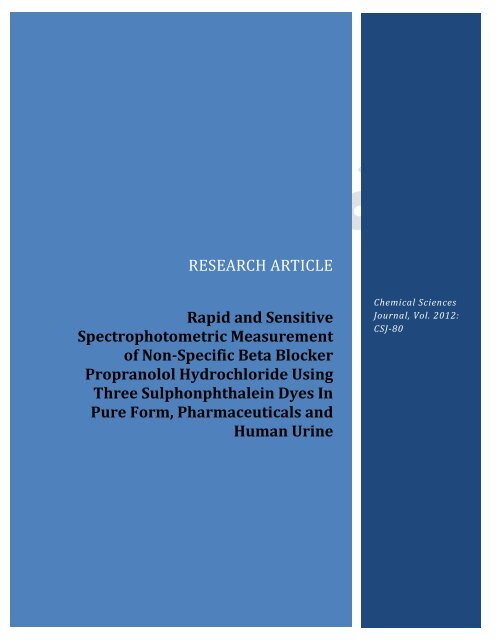
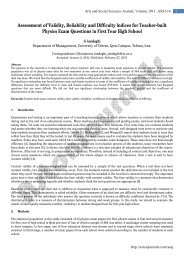
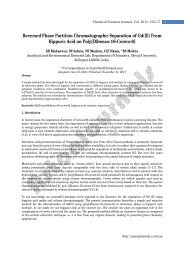
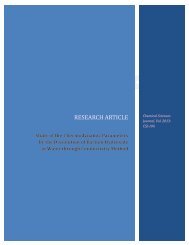
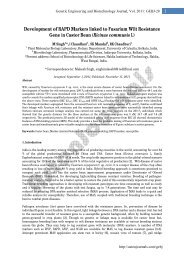

![[1,4]-benzodiazepine-2-one Derivatives as Potent - AstonJournals](https://img.yumpu.com/49117784/1/184x260/14-benzodiazepine-2-one-derivatives-as-potent-astonjournals.jpg?quality=85)
